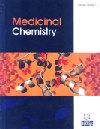计算化学:预测靶向合成化合物的可及性
IF 1.9
4区 医学
Q3 CHEMISTRY, MEDICINAL
引用次数: 0
摘要
简介:本研究合成了一系列新型吡啶羧酰胺 3(a-h),并对其进行了抗菌活性筛选。这项研究探索了密度泛函理论(DFT)在量子力学层面研究生物系统中的应用,尤其是在药物设计方面。密度泛函理论提供了一种简化的量子力学计算方法,使其成为各个科学领域不可或缺的工具,并因其卓越的准确性、计算时间的缩短和成本效益的提高而成为计算化学领域举足轻重的工具。这项研究工作的重点是将 DFT 研究与 POM 分析相结合,从而有效地确定药效位点。此外,该研究还结合了默克药代动力学分析,以评估合成化合物的药代动力学特性。论文重点研究了之前报道过的一系列化合物,旨在全面了解这些化合物的电子结构、药效特征以及作为候选药物的潜力。这项研究不仅有助于不断发展的计算化学领域,而且通过将理论见解与实际分析相结合,对推进药物设计过程具有重要意义。研究方法使用 B3LYP/6-31G(d) 基集对化合物 3(a-h) 进行密度泛函理论(DFT)计算,以获得优化的几何结构。高斯视图用于显示最高占有分子轨道(HOMO)和最低未占有分子轨道(LUMO)的贡献。能隙的确定使用了高斯 09W。使用 Osiris、Petra 和 Molinspiration 等现有技术以及名为 POM Analyse Results 的新型平台对药物动力学曲线进行了评估:计算研究 DFT、POM 和硅学药代动力学研究表明,所研究的化合物具有生物活性、无毒、不致癌,可用作候选药物。结论密度泛函理论(DFT)研究强调了复合物 3d 的特殊稳定性,它具有最大的能隙和最低的软度。相比之下,化合物 3h 在测试化合物中表现出较低的稳定性,具有最低的能隙和最高的软度值。绝对能量计算进一步证实了这些发现。化合物 3h 的能量差可以忽略不计,这表明分子内的电荷转移增加了,这与其生物有效性的提高有关。这些化合物的药物相似性得到了 POM 和硅药代动力学研究的证实,其中化合物 3h 被确定为所研究化合物中生物活性最高的化合物。本文章由计算机程序翻译,如有差异,请以英文原文为准。
Computational Chemistry: Prediction of Compound Accessibility of Targeted Synthesized Compounds
Introduction: In the present work, a series of novel pyridine carboxamides 3(a-h) were synthesized and screened with antibacterial activity. This research explores the application of Density Functional Theory (DFT) in studying biological systems at the quantum mechanical level, particularly in the context of drug design. DFT offers a streamlined approach to quantum mechanical calculations, making it indispensable in various scientific fields, and for its exceptional accuracy, reduced computational time, and cost-effectiveness has become a pivotal tool in computational chemistry. This research work highlights the integration of DFT studies with POM analyses, which effectively identify pharmacophoric sites. Moreover, the research incorporates in silico pharmacokinetics analyses to assess the pharmacokinetic properties of synthesized compounds. The paper focused on a series of compounds previously reported, aiming to provide a comprehensive understanding of their electronic structure, pharmacophoric features, and potential as drug candidates. This study not only contributes to the evolving field of computational chemistry but also holds implications for advancing drug design processes by combining theoretical insights with practical analyses. Methods: The compounds 3(a-h) were subjected to Density Functional Theory (DFT) computations using the B3LYP/6-31G(d) basis set to get optimized geometric structures. GaussViewis used to display the contributions of the highest occupied molecular orbital (HOMO) and lowest unoccupied molecular orbital (LUMO). The determination of energy gaps was conducted using Gaussian 09W. The pharmacokinetic profiles were evaluated using existing techniques such as Osiris, Petra, and Molinspiration, as well as a novel platform called POM Analyse Results: The computational studies DFT, POM and in silico pharmacokinetics studies revealed that the studied compounds are biologically active, non-toxic, non-carcinogenic in nature and may be utilized as drug candidates. Conclusion: Density functional theory (DFT) investigations emphasize the exceptional stability of complex 3d, which possesses the biggest energy gap and the lowest softness. In contrast, compound 3h demonstrates poorer stability among the tested compounds, characterized by the lowest energy gap and the highest softness values. These findings are further substantiated by absolute energy calculations. The negligible energy difference in compound 3h indicates an increased transfer of electric charge within the molecule, which is associated with its enhanced biological effectiveness. The drug-likeness of the compounds is confirmed by POM and in silico pharmacokinetics investigations, with compound 3h being identified as the most biologically active among the investigated compounds.
求助全文
通过发布文献求助,成功后即可免费获取论文全文。
去求助
来源期刊

Medicinal Chemistry
医学-医药化学
CiteScore
4.30
自引率
4.30%
发文量
109
审稿时长
12 months
期刊介绍:
Aims & Scope
Medicinal Chemistry a peer-reviewed journal, aims to cover all the latest outstanding developments in medicinal chemistry and rational drug design. The journal publishes original research, mini-review articles and guest edited thematic issues covering recent research and developments in the field. Articles are published rapidly by taking full advantage of Internet technology for both the submission and peer review of manuscripts. Medicinal Chemistry is an essential journal for all involved in drug design and discovery.
 求助内容:
求助内容: 应助结果提醒方式:
应助结果提醒方式:


